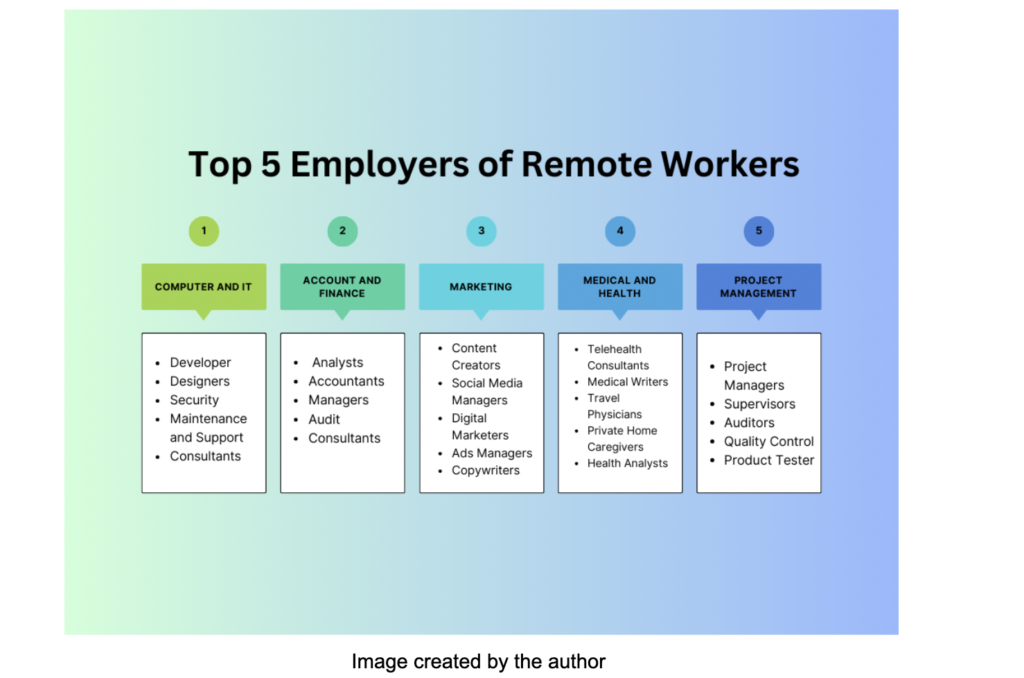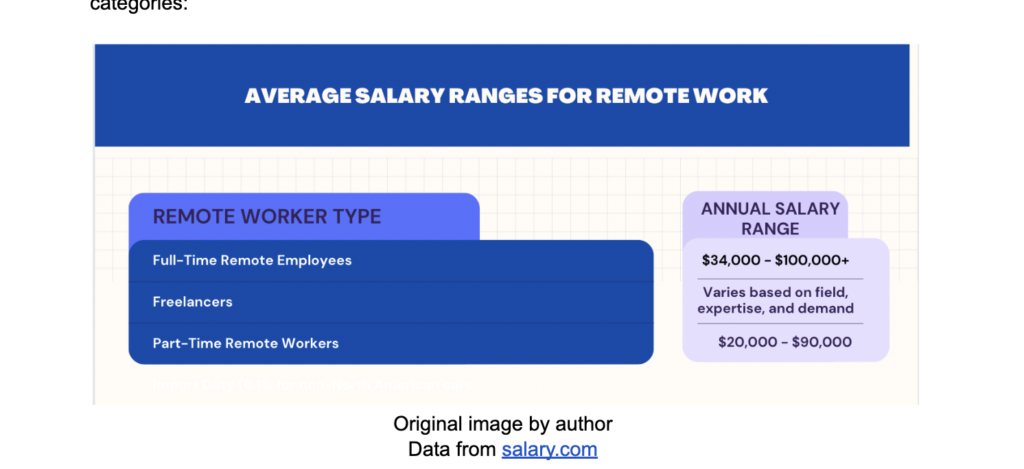The recent global pandemic, etched into our collective memory, brought about unprecedented challenges and shattered the conventional belief that corporate work hinges on employees being confined to office desks. But there are plenty of types of remote workers that have been working long before the pandemic.
Remote work, admittedly, was already a well-established practice long before the pandemic emerged. Freelancers and digital consultants had already been seamlessly working remotely. The global adoption of remote work gained momentum with the onset of the pandemic.
Today, remote work is the dominant work environment.
According to a survey by Gartner, approximately 48% of employees now work remotely at least part of the time. Due to advancements in enterprise applications and remote collaborative solutions, this number will only increase. And with it, different types of remote-friendly roles are emerging from the mold.
Here, you’ll learn the various types of remote work, how they contribute to workplace productivity, and types of remote work salary.
Boost your team’s efficiency with Hubstaff's productivity tools
Different types of remote employees
Working remotely revolves around work arrangements where employees do their work remotely. That could be from home or in a co-working office, usually in any time zone you choose.
Remote work often comes with low barriers to entry. This means opportunities exist for everyone searching for remote jobs, even those without experience. Most people could work remotely. Working remotely is also available to top talent.
Remote working is now a perk most people would like to have. Why? Remote work offers flexibility, work-life balance, and convenience, allowing different teams to collaborate in a remote work environment without location restrictions.
Below are the common types of remote work.
Full-time remote employees
Full-time remote employees have permanent working contract agreements with an organization, giving them job security while working remotely from any location.
An explicit work-from-home policy is essential if your entire team is working remotely.
Employees of this type of remote team enjoy the benefits of being fully remote with an organization, a flexible schedule, and the autonomy to manage their remote environment.
Common remote work roles include, but aren’t limited to, software development, customer support, project management, and content creation.
Full-time remote employees often exhibit characteristics that showcase an ability to work without much supervision. These include effective communication skills, self-motivation, experience with digital tools, and the ability to collaborate seamlessly in virtual environments.
Freelancers and contract-based remote employees
Freelancers and contract-based remote workers are independent professionals who temporarily offer their services to clients.
A defining characteristic of individuals in this category is that they do not tie themselves to specific employers. Instead, they have more flexibility to work with various clients on a project-by-project basis.
Contract-based workers enjoy the flexibility and freedom to work remotely with multiple clients from different locations. Think of it as a sole proprietor business where they’re responsible for managing their schedules and client relationships.
Freelancers reserve the full right to determine their working conditions, including location, time, and remuneration. They use tools like time tracking apps to measure productivity, allowing them to tailor their workload to their preferences and ensure fair remuneration.
Part-time remote employees
A remote job only sometimes means working from home. Take part-time remote workers who split their work between a physical office and a remote location.
These types of employees enjoy a hybrid work model as a compromise between traditional office structures and the flexibility of remote work.
The typical hybrid or part-time remote worker doesn’t go to the office five days a week. Their job arrangements may require them to go into the office occasionally. Depending on their pre-arranged schedule with the employer, they may need to go to the office a few days a week.
Alternatively, a part-time remote worker may only need to go to work periodically, such as during special events.
This type of remote worker benefits from more flexibility than the typical full-time onsite worker. They also enjoy the cost-savings from reduced commuting needs while maintaining in-person collaboration with colleagues.
Most part-time workers take on roles where their constant physical absence doesn’t influence the quality of their work. For example, data analysts, project managers, product managers, graphic designers, and customer service reps can comfortably manage hybrid positions.
Remote jobs across various industries
Nowadays, there are different kinds of remote jobs for employees across various industries. More and more organizations are now open to letting their staff work from home.
Image Sourced from Statistica
Common remote roles in tech, marketing, and more
Here are the top five fields that hire remote employees.
Computer & IT
The computer and IT industry is chock-full of remote jobs that pay well. The industry is vast and rapidly growing, but in its current state, it provides remote openings for workers in the following categories.
- Development – includes software, hardware, and infrastructure development. Developers are the creators; they bring ideas to life and turn imagination into reality using computer codes and resources. For the most part, they can write codes from anywhere with a PC and internet connection.
- Design – includes graphics designers, animators, motion graphics experts, and others who create visual experiences. These kinds of remote jobs offer the most opportunities to individuals with no work experience, as expertise often depends on their observable skills.
- Security – includes cybersecurity experts responsible for identifying, analyzing, and preventing malicious attacks on digital systems. Most of their activities involve software systems that they can access from anywhere at any time.
- Maintenance and Support – includes workers who attend to user complaints or inquiries about software systems. Their work directly impacts CSAT (customer satisfaction) because they provide support, maintenance, and repair services that can affect user experience.
- Consultants – includes experts with a wide range of computer solutions and IT systems knowledge. They usually work as advisors, giving companies recommendations on implementing the right tech stack for their operations.
Accounting & finance
The finance industry is another big employer of remote workers. Most finance activities involve crunching numbers and data— all processes that have become digital.
Common roles in this field include:
- Finance Managers.
- Accountants – Tax, Forensic, Budget, and Management.
- Analysts – Financial, Budget, investment, Credit, and Business.
- Audit – Compliance officer, Auditor.
- Consultants.

Marketing
The marketing field employs remote freelancers and contract workers because most companies don’t set up robust in-house marketing teams. Instead, they seek outside assistance when it’s time to roll out major marketing campaigns.
For example, companies scarcely employ in-house content creators, social media managers, digital marketers, or ad experts.
Instead, they prefer to hire remote teams or individuals leveraging remote collaborative solutions to work on active marketing campaigns for an agreed-upon period.
Medical & health
The health industry’s presence on this list may be somewhat surprising since health service providers have traditionally had to attend to patients in person.
But thanks to technology, some health workers can now take on part-time remote roles. For example, developing health tech and telemedicine solutions have fueled the increase in remote health roles.
Some of the top examples of remote job descriptions in the health industry include
- Traveling Physicians – This category includes workers who provide medical care to travelers in transit.
- Medical Writer/ Content Creator – These workers may or may not provide direct health services, but they provide intellectual resources on medical practices and health topics.
- Telehealth Consultants – They correspond with patients through video conferencing or calls and offer expert recommendations. Telehealth consultants can also give patients access to professional health services from the comfort of their homes.
Project management
Project managers often engage in part-time remote work, depending on the nature of their projects.
Since companies don’t consistently launch projects in quick succession, project managers may not be continuously engaged. Consequently, they have more opportunities to work from home.
Consider the context of digital product development. For instance, in a project involving a content creator, software developers, and an accountant working remotely, effective remote communication strategies become crucial for project management success.
In such a scenario, it is reasonable to anticipate that the project manager would work remotely, whether part-time or full-time.
Administration
The administrative field employs a mix of all types of remote workers. Several organizations employ part-time administrative staff. On the other hand, smaller business owners may opt to employ freelance or contract-based virtual assistants.
Virtual assistants provide administrative services to their clients virtually. Their responsibilities may include appointment scheduling, creating travel arrangements, making phone calls, and managing email accounts on behalf of their clients.
Interestingly, there are now AI systems that can augment these responsibilities. For instance, deploying the best virtual assistant AI can improve the productivity of any administrative staff you hire and save costs.
Image Sourced from Forbes
Emerging remote work opportunities
Continuous tech advancement paves the way for discoveries and applications in every field. Expectedly, it creates employment opportunities for people looking for different types of remote jobs who need more experience.
In IT, new systems are always emerging, creating new requirements for specific skill sets, such as virtual reality developers, blockchain developers, machine learning experts, AI trainers, and data analysts.
Similarly, companies now want to hire data analysts to leverage big data for business and marketing decisions. Employees in these roles can effectively collaborate remotely, pushing the boundaries of traditional office-based work.
Finally, the global shift towards more decentralized work structures opens up innovative opportunities for individuals to contribute to various industries from the comfort of their homes.
Remote work salaries and compensation
Understanding the salary trends among different remote workers is crucial for employers and employees.
Salary trends among different remote worker types
The compensation landscape for remote work can vary based on factors such as the nature of the work, the level of expertise required, and the industry.
Below is a comparative analysis of average salary ranges for various remote work categories:

Data from salary.com
A recent RingOver survey reports that remote workers earn about $8,555 more than in-office roles. With this in mind, you should also note that the figures in the table above are general estimates, and the different types of remote workers’ salaries may vary based on experience, skills, and geographic location.
Factors influencing remote worker salaries
- Skill-set and sxpertise: Highly specialized skills, especially in technology and design, often command higher compensation.
- Experience: Seasoned remote workers with a proven track record may receive higher salaries than those with less experience.
- Industry demand: The types of remote jobs that pay well have a high demand for specific skills within that industry. Fields experiencing a talent shortage may offer higher compensation to attract skilled professionals.
- Geographic location: Remote workers based in regions with a higher cost of living may receive higher salaries to compensate for the increased expenses.
- Company policy: The compensation philosophy of a particular company, its size, and financial health also play a role in determining remote worker salaries.
Conclusion
The landscape of remote work is diverse, encompassing various types of remote teams across different industries. Full-time remote employees, freelancers, and part-time remote workers each contribute to the evolving nature of the modern workforce.
As the world embraces remote work, staying informed about the evolving trends in the remote job market can contribute to company success and business competitiveness.

When you decide what kind of remote workers your team needs, Hubstaff is here to make the transition streamlined and productive. Explore Hubstaff’s suite of remote work management solutions, from time tracking to agile visual project management.
Most popular
The Critical Role of Employee Monitoring and Workplace Security
Why do we need employee monitoring and workplace security? Companies had to adapt fast when the world shifted to remote work...
15 Ways to Use AI in the Workforce
Whether through AI-powered project management, strategic planning, or simply automating simple admin work, we’ve seen a dramatic...
The AI Productivity Panel: Lessons From Leaders on What’s Working (and What’s Not)
When I moderated this AI productivity panel, I expected a solid conversation. What I didn’t expect was the flood of real-world i...
Employee Performance Dashboards: Templates, Tools, and Best Practices
Keeping track of how your team’s really doing can be tricky. Spreadsheets pile up, one-on-ones only tell part of the story, and...





